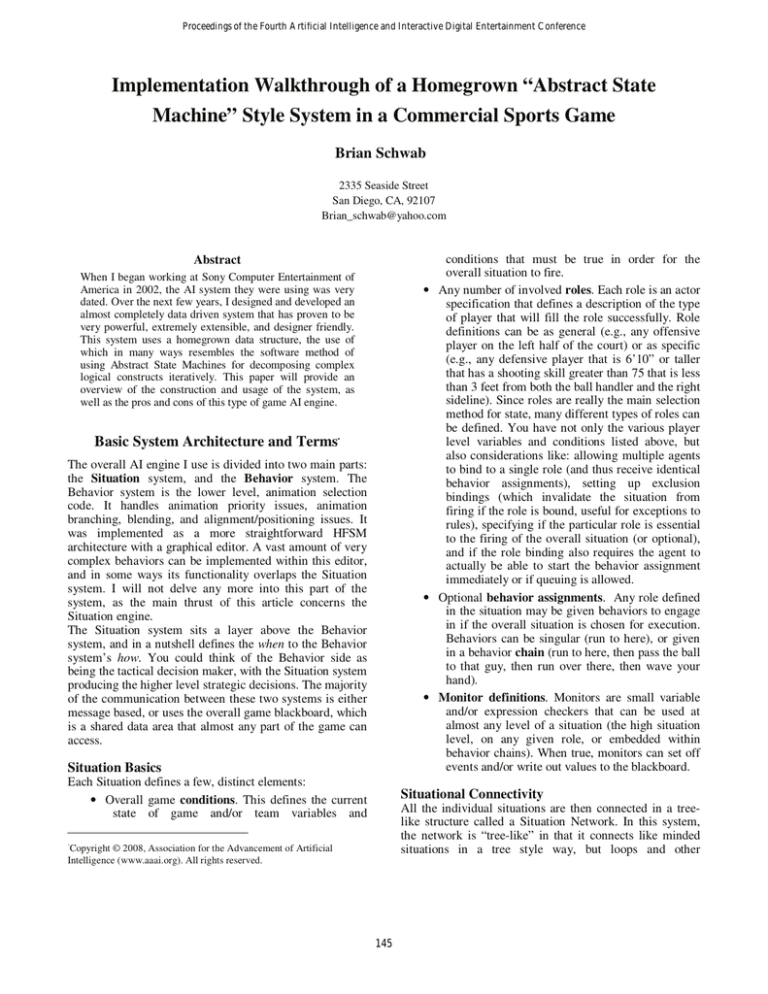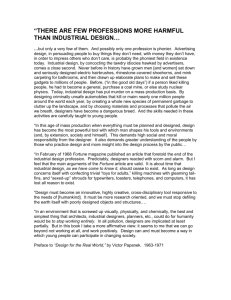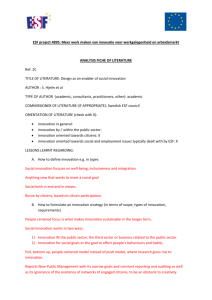
Proceedings of the Fourth Artificial Intelligence and Interactive Digital Entertainment Conference
Implementation Walkthrough of a Homegrown “Abstract State
Machine” Style System in a Commercial Sports Game
Brian Schwab
2335 Seaside Street
San Diego, CA, 92107
Brian_schwab@yahoo.com
conditions that must be true in order for the
overall situation to fire.
• Any number of involved roles. Each role is an actor
specification that defines a description of the type
of player that will fill the role successfully. Role
definitions can be as general (e.g., any offensive
player on the left half of the court) or as specific
(e.g., any defensive player that is 6’10” or taller
that has a shooting skill greater than 75 that is less
than 3 feet from both the ball handler and the right
sideline). Since roles are really the main selection
method for state, many different types of roles can
be defined. You have not only the various player
level variables and conditions listed above, but
also considerations like: allowing multiple agents
to bind to a single role (and thus receive identical
behavior assignments), setting up exclusion
bindings (which invalidate the situation from
firing if the role is bound, useful for exceptions to
rules), specifying if the particular role is essential
to the firing of the overall situation (or optional),
and if the role binding also requires the agent to
actually be able to start the behavior assignment
immediately or if queuing is allowed.
• Optional behavior assignments. Any role defined
in the situation may be given behaviors to engage
in if the overall situation is chosen for execution.
Behaviors can be singular (run to here), or given
in a behavior chain (run to here, then pass the ball
to that guy, then run over there, then wave your
hand).
• Monitor definitions. Monitors are small variable
and/or expression checkers that can be used at
almost any level of a situation (the high situation
level, on any given role, or embedded within
behavior chains). When true, monitors can set off
events and/or write out values to the blackboard.
Abstract
When I began working at Sony Computer Entertainment of
America in 2002, the AI system they were using was very
dated. Over the next few years, I designed and developed an
almost completely data driven system that has proven to be
very powerful, extremely extensible, and designer friendly.
This system uses a homegrown data structure, the use of
which in many ways resembles the software method of
using Abstract State Machines for decomposing complex
logical constructs iteratively. This paper will provide an
overview of the construction and usage of the system, as
well as the pros and cons of this type of game AI engine.
Basic System Architecture and Terms.
The overall AI engine I use is divided into two main parts:
the Situation system, and the Behavior system. The
Behavior system is the lower level, animation selection
code. It handles animation priority issues, animation
branching, blending, and alignment/positioning issues. It
was implemented as a more straightforward HFSM
architecture with a graphical editor. A vast amount of very
complex behaviors can be implemented within this editor,
and in some ways its functionality overlaps the Situation
system. I will not delve any more into this part of the
system, as the main thrust of this article concerns the
Situation engine.
The Situation system sits a layer above the Behavior
system, and in a nutshell defines the when to the Behavior
system’s how. You could think of the Behavior side as
being the tactical decision maker, with the Situation system
producing the higher level strategic decisions. The majority
of the communication between these two systems is either
message based, or uses the overall game blackboard, which
is a shared data area that almost any part of the game can
access.
Situation Basics
Each Situation defines a few, distinct elements:
• Overall game conditions. This defines the current
state of game and/or team variables and
Situational Connectivity
All the individual situations are then connected in a treelike structure called a Situation Network. In this system,
the network is “tree-like” in that it connects like minded
situations in a tree style way, but loops and other
.
Copyright © 2008, Association for the Advancement of Artificial
Intelligence (www.aaai.org). All rights reserved.
145
specialized traversal methods can be set up, making the
network more like a graph.
Because of the massive dynamic interconnectedness of the
states within a real-time sports game, I didn’t want to go
with a straight state graph. The lines of state connectivity
would quickly become unwieldy. Other HSM
diagramming methods (like embedded states: where a large
box is a parent state, and any smaller boxes inside of it are
thus child states) have proven very un-intuitive to
designers, and also makes loops hard to see. The decision
tree structure makes a lot of sense to most people, and by
extending the way that we traverse a decision tree, we can
still get graph like behavior out of it.
However, by using a tree like structure, we have also made
it slightly more difficult to see specific loops or jumps in
logic. What I use instead is specific embedded formatting
visualizations within the editor (color coding, use of icons,
and a scoping window), so that authors using the tool can
see jumps in state flow without mucking through tons of
connectivity lines.
•
•
Polling Group Basics
•
Each situation can live on its own, or have any number of
Situation “Polling Groups” (PGs) beneath it. These PGs
are actually just folders of additional situations that provide
the author with the method for grouping child situations
under specific settings for situational type, scoping, role
inheritance, priority, polling policies, and exit policies.
• Situational types include persistency, and
abstractness. Persistency is like the program
counter of the overall Situation network; it marks
the currently running master situation that
controls the current scope of the tree. Only one
persistent situation is running at any given time.
Entering a new persistent situation will cause all
roles involved to stop what they were doing (if
possible) and start something else when they fire.
Non-persistent situations don’t upset the current
state of the tree; they only override specific
individuals with behaviors. So, if the overall game
is running a persistent situation, several players
can be given other tasks without interrupting the
overall state of the game. An abstract situation is
one that includes no behavioral assignments to
any of the included roles. These situations are
pure decision tree nodes, serving only as
placeholders for logic (or monitors). They fire if
true, but then immediately poll their children, so
that a non-abstract situation can be reached that
will give the players some behavior.
• Scoping involves a few things. At any level of the
tree, situational authors can define interruptability
(meaning, which situations can interrupt any
given executing situation) with a few different
methods. The structure of the tree itself obviously
gives one level of scoping. Interrupt Flags can
also filter out situations that you don’t wish to
pre-empt currently running situations. These are
•
just group bitfield flags, which function as a
rudimentary ID, that you can tag onto any
situation. Each situation can then list which
flagged situations it will allow to interrupt. Lastly,
overall PG priority level (discussed below) will
also limit other groups with lower priority from
coming along and taking control.
Role Inheritance allows the authors to actually
bind players to roles in an inherited fashion. You
can either define roles as further specifications on
older roles, or you can inherit the specific player
that was bound to a role in any parent situation.
This is very useful as a kind of role history, where
you are able to refer back to roles that happened
in the past and gain access to the specific player
involved.
Polling priority is simply a number that the system
uses for ranking situations in terms of
“importance.” High priority situations are not only
checked first, but cannot be interrupted by lower
priority situations.
Polling policies determine how a given folder of
situations is “tested for truth”. The policy can be
set to: polling on a tick basis (either every tick, or
some schedule), purely event based (meaning not
polled at all, but becoming active only when a
specific event comes in), and a number of
miscellaneous policies like OnReset (which
means “poll this folder every tick until a situation
fires, and then don’t poll at all until that situation
exits or is aborted”). Other miscellaneous policies
include OnEntry/OnExit (which are folders that
are only checked upon entry or exit of the parent
situation), and OnTickCheckPriors (which polls
an entire folder until something fires, and then
will continue to poll situations higher in the folder
then the one currently executing; this is useful for
heavily prioritized setups).
PG exit policies are just as varied. Some examples
include: exit when all behaviors are done, after
some set time period, or when any leaf node
underneath you has exited. You can also set up a
Monitor to watch for a customized exit strategy,
and either have the monitor exit directly, or have
another situation communicate back that it is time
to exit.
Architecture
Although I refer to this system as a type of “Abstract State
Machine,” it in no way follows rigorously the classical
ASM syntax. In fact, I was not aware of the ASM design
methodology until well into the second year of
development of the system.
However, the concepts of ASM use have dovetailed so
nicely with my system’s design that we have essentially
146
In only a few years, the system has gone from being
primarily a tool for programmers to something that most of
the team uses for a large number of AI-related activities.
Designers are currently almost completely in charge of the
primary game AI. Artists use the system directly to do
simple, art driven AI for groups of agents like the crowd.
Non-gameplay programmers use the system for
presentation, sound, and camera tasks.
The system uses a mixture of debugging information. Ingame diagnostics and visual debugging info is
complemented by logging and a full game recording and
playback system. While the game is running, you can
pause, rewind the action, and then bring up debug
information pages that will show you what situations are
currently active, as well as what situations were tested on
each tick, and why they failed to fire. This last year we also
put in a system to update situations on the fly, so that
authors could change a situation in the editor, and send it
directly to the development kit while the game is running.
This allowed for much more rapid iteration on situations,
since it cut out some of the turn-around time associated
with packing up data files, and lengthy restarts of the
game.
Debugging can also be achieved from within the system
itself. Much like putting special code into a function to
help debug a twisty logical construction, situation
designers are able to construct “helper situations” that will
force the game into specific setups, or allow other
backdoors to get quickly to particular game conditions.
Then, key situations can be tested for much more easily
then waiting until the specifics might happen during a live
game. These helpers are then discarded once the situation
is operating as wanted.
The only parts of the system that are still currently “codebased” are the perception system and the low level
animation helpers (which in our game are called Smart
Targets and Motion Controllers). Perceptions are in-game
variables that can be accessed by the rest of the system;
things like “distance to the ball” or “am I in the back half
of the court” and the like. Smart targets are structures that
manage positions a particular behavior is headed towards,
with automatic avoidance, occupancy concerns, and
specialty placement algorithms controlled by code. Motion
controllers are special functions that help with low level
custom animation issues. Note that there are currently
plans to data drive both the perceptions and the smart
targets using the situation system.
been using the ASM method for dealing with our AI since
the implementation of this new system.
We begin by building “ground models” to form
requirement specifications for new features that the game
will require. We then gradually build up these models into
a full solution with iterative passes that slowly increase in
complexity and specificity. Also, the rule-based nature of
ASMs lends well to expert-knowledge filled environments
like professional sports. Sporting games have not only well
documented rules of play, but well documented individual
player statistics and tendencies, which form the basis of
“secondary” simulation rules. In this way, we can start
construction of new AI logic quickly, without having to
consider the minor details of implementation. We can then
later add as much depth to any part of the AI as we see fit
and have time for.
Like an ASM, situations in this system can describe states
that themselves are not really points in the state space, but
rather form algorithmic relations between variant areas of
state space. The situational structure provides both the
transitional rules (by way of the structure itself and the
interruptability rules) as well as the behavior at each state
within the situations.
In a way, both ASMs and my structure provide a sort of
combination of State Graph and Decision Tree. Since rules
can be used at any point to delineate either state transitions
or selection criteria, you can freely “switch” between
encoding logic in a decision tree format with logic
embedded in state machine style format, depending on the
author’s needs at the time. Abstract situations give the
author pure decision tree ability, creating deep logical
structures that are parsed to separate out complex game
state conditions. Interruptability flags, polling policies, and
control over scoping issues give designers a huge amount
of leeway as to how the situation states connect to one
another.
Finally, the use of role inheritance greatly increases the
author’s ability to build coherent, richly structured
behavior. By allowing the situation builder to re-use old
roles and/or build upon old role designations, he can
sequence very complex chains of behavior in an intuitive
and straightforward manner. Authoring classical state
based behaviors that reach a decent level of complexity can
become quite difficult; the author has to think ahead, and
construct all the substates inside of a larger parent state that
can contain all the intermediate variables and roles
necessary for inheritance (or else incur a fairly sizable
refactoring task). In this system, the author can just build
situations as he normally would, and when he wants to
inherit from a parent, he can do so with a few mouse
clicks.
Benefits of the system
The system allows for very rapid creation of complex
synchronized AI behavior chains. The combination of
easy, inherited dynamic role binding and the vast array of
options allow almost any AI problem multiple solutions.
The first year the system was in place, I implemented the
first round of AI behavior using the system myself. The
total XML file size for the core game AI was around 700k.
The next year, a designer was assigned to learn the system,
System Usage
The system was designed for a few things: to enable game
designers the ability to directly develop complex AI
systems, and to not overly limit the power of the system by
dumbing it down. Overall, the system was very successful.
147
in-game tools for the majority of our efforts. This means
the standard hit for any data driven system, in that you are
not only working on maintenance of your product, but are
now also linked to the maintenance of the AI tool chain.
Time budgets must now be split between tool upgrades,
and other coding areas that need attention. However, by
keeping the system very open ended and powerful, we
have escaped the vast majority of major overhauls that
would have been needed had we limited the tool in the
beginning (in the name of simplicity). Over the last two
years, the tools have really only changed in small ways, as
special circumstances have come up where the designers
wanted specific new features from the system.
and I moved into more of a support role (as far as the core
AI was concerned, I was really working more on extending
and debugging the system). The AI file size doubled in
only 6 months of designer time. The year after that, three
more designers were assigned, and the AI content grew to
almost six times its original size. On top of that, an
additional megabyte or so of AI data was produced for
other elements in the game.
The ability to tweak polling policies and the like give the
system an amazing ability to tune for performance. The
first year, we were able to make the system run in one-third
the CPU time with only two days of tuning, and without
any degradation of AI game performance. Now that the
designers know some general rules of thumb about
scheduling as well as limits on the number of situations we
can check per tick of execution, they can tune the game
themselves for performance using the in-game debugging
tools.
Conclusions
This flavor of free form state tree has vast potential for
game development. It provides intuitive authoring of
chains of behavior through a state based interface, while at
the same time overcoming some of the limitations of
typical FSM or HFSM systems by extending the paradigm
with role inheritance and polling/exit policies that allow for
a stunning amount of control over program flow.
Overall, the system has been a huge boon to our current
product, and the extended system is being used in other
products that we are working on in-house. We are
continually trying to make the user interface of our editing
tools better, as well as improving the debugging systems
and author help techniques. I feel that on the whole I have
learned a great deal about creating highly extensible AI
systems, while at the same time gaining valuable insight
into how to get non-technical staff into the game of AI
development.
Drawbacks of the system
The Situation editor has quite a hefty learning curve. With
all the available options and settings, it takes
approximately a week of instruction and plenty of
examples and documentation to really get a programmer to
use the system with competency. Designers took a bit
longer as you might have guessed. However, considering
that the system is powerful enough that, like c++, it is
almost trivially easy to author constructions that do
absolutely nothing useful; we have had huge success in
getting non-technical staff to embrace classical
programming concepts like logical constructs, scoping
issues, and inheritance. In fact, within a year or so of
working within the system, some designers were asking for
exotic new polling policies and priority systems as they
constructed elaborate setups that had never occurred to us
before.
However, this brings up a point. The system is very
powerful. It is essentially a full blown visual
“programming language” for developing the game AI. As
such, we’ve had to deal with many of the problems
associated with green programmers, except with our
designer staff. Teaching good programming practices to
our designers has become part of my job. Like stubbing out
behavior trees with default behavior and then adding
higher priority specialization, so that AI controlled players
will always have something to do. Even the intricacies of
using version control software, including XML based
merging and diffing of files to make sure that they’re not
checking in garbage. We have even begun to notice that
many of the designers suffer from beginning programmer
maladies such as the “I want to re-do everything myself”
syndrome. It has been interesting finding out that
programmers aren’t alone when it comes to many of these
types of professional behaviors.
As with any heavily data driven system, debugging is
always an issue. Without a dedicated debugger, we rely on
148



